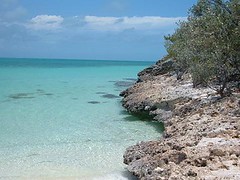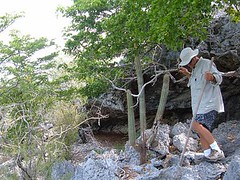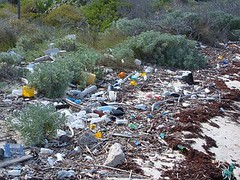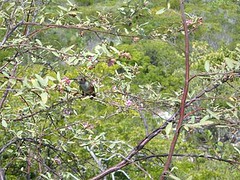May 1- May 4, 2007
Buenavista Cay lies about 30 miles south of Flamingo Cay, so it took us almost 4 hours of bumpy cruising (more wind) to get here. We're anchored off a sandy beach over a mile long with good holding, so I will have less worry about FLUKE trying to venture out on her own when the wind kicks up. One sailboat was here when we arrived and two others came in later the same day.
Good views
That's what the name of the cay suggests, and that's appropriate. The ¼ mile wide island is about 2 miles long with a couple of 50' hills. There are two gaping caves tucked into one of the hillsides, and they are open to our anchorage so we can see them from the boat.
There are several lowland ponds, now mostly drying up, whose perimeters are circled with silver buttonwoods whose shimmering leaves are in vivid contrast to the other green vegetation. Scattered on the hills are huge Agave (Century) plants, many blooming with their colorful spikes towering 20' in the air. They used to be grown for their fibers which were made into sisal for various rope-like products.
We are anchored off a thin, very white sandy beach that stretches 1 ½ miles. The waters and beach are mostly clean of trash on this Banks side, but a dinghy trip to the windward, open ocean, side of the island revealed enormous amounts of cruise ship garbage, the most we've ever seen in one place. We continue to wonder how those commercial passenger ships can still get away with throwing their garbage overboard, no matter how deep is the sea or far from any land. Plastic lasts forever.
We found a path, well marked by old buoys hung on the vegetation, that took us over one of the hills and all the way to the ocean side. It was mostly high and rocky but had a small pocket beach set within the rocks. We love to hunt through what the sea has washed up, usually looking for shells or interesting pieces of driftwood. However, no shells are found on the ocean side of any of these islands because the coast is just too rocky and the offshore sea bottom doesn't provide a good habitat for mollusks. Every beach combing cruiser dreams of finding the most sought after prize: a glass ball from an old fishing net. We of FLUKE search diligently, but as of yet, have not met with success.
Critters
We awake each morning to the raucous sound of a flock of several hundred laughing gulls who roost on the island during the night and then fly out onto to the Banks during the day. At dusk they return, just as noisily. FLUKE has been showered from above during the daily migration, and I won't stand out on deck when they are passing overhead. I have never seen a bigger flock of birds anywhere in the Bahamas.
As I was trying to take a photograph of one of the flowering plants, a hummingbird zoomed right into the same plant to gather nectar from the flowers, not 2' from my hands. I actually heard its beating wings before I saw the bird.
There is a resident population of goats. We can hear them bleating from the boat and have seen them drinking from the lowland pond areas. When we hiked to the caves, they stunk with the smell from the goats who had sought refuge in them from the heat and wind.
Absent are the big, bold, slow curly tail lizards that sat on the rocky outcroppings on Flamingo. Here, they are replaced by the quick, shy, blue lined skinks that stay mostly hidden in the underbrush. Ursa has a difficult time lunging at them.
Night life of the deep
May 2 marked the day of the first full moon of May. The Bahamian fisherman head out onto the Banks on this night to try to fish for mutton snapper, for reasons I know not why. If it works for them, then it must work for us too.
For the last several years I have been telling Eddie we need to go for a night snorkel. We haven't got around to doing this for various reasons, the biggest one being that we have just been too chicken. Well, I have convinced us our fears are unfounded (I hope!), and we had to commit to doing one. What better time than a full moon? Plus, one more big factor was in our favor: less than 50 yards from where we are anchored is a wonderful coral head which I named the Disney Reef because of all the numerous species of fish which use it for their meeting place. So, we made the pact to go for it.
As luck would have it, the sky was completely clouded over during the early evening when we were still awake enough (cruisers don't stay up too late!) to go into the water. Lightning was popping in the sky to the east of us. I suggested maybe we do it another night, but Eddie already was getting suited up and said we just needed to press onward and carry out the plan anyway.
In we went, with one light between the two of us, so we stuck together like Siamese twins. It was a strange feeling to just be able to see only what was in the beam of the light, especially knowing during the day how quickly different fish can just swim into your field of view from out of nowhere.
Night life at the Disney Reef was certainly different than that of the day; the colors weren't as vibrant and activities were slower. Fish were lying more idle within the holes in the rocks. Many schools had moved off the coral head into the open grassy areas, huddled close together moving as one. Ghost-like bioluminescent organisms softly floated through the water, disturbed by our movements, spiraling with iridescent rainbow colors. Fast moving, tiny insect-like creatures were drawn to the light, sometimes clouding the entire beam in front of the lens. We could feel them bouncing off our masks. Everything seemed so peaceful and quiet. Sometimes a lone fish, like a big jack, would zoom across the beam of our light and swim quickly out of sight again. The beam caught the sparkling golden eyes of a spiny lobster as it moved from one rock ledge to another. The event was worth the effort, our fears were unfounded, and we are looking forward to dropping in after dark again.
Friday, May 18, 2007
Subscribe to:
Post Comments (Atom)












The Mutton Snapper spawn is a much anticipated event. It occurs on the full moon in may and june when they gather in large groups in depths from 50' out to 200'. Mutton normally like to hang in depths of over 100'. They are consider by many anglers to be the tastiest of all Tropical reef fish yet you would rarely see them on a menu outside the islands or the Keys.
ReplyDelete